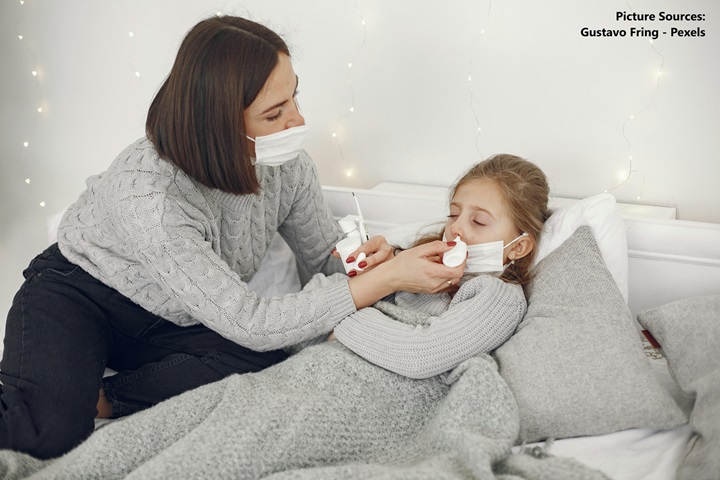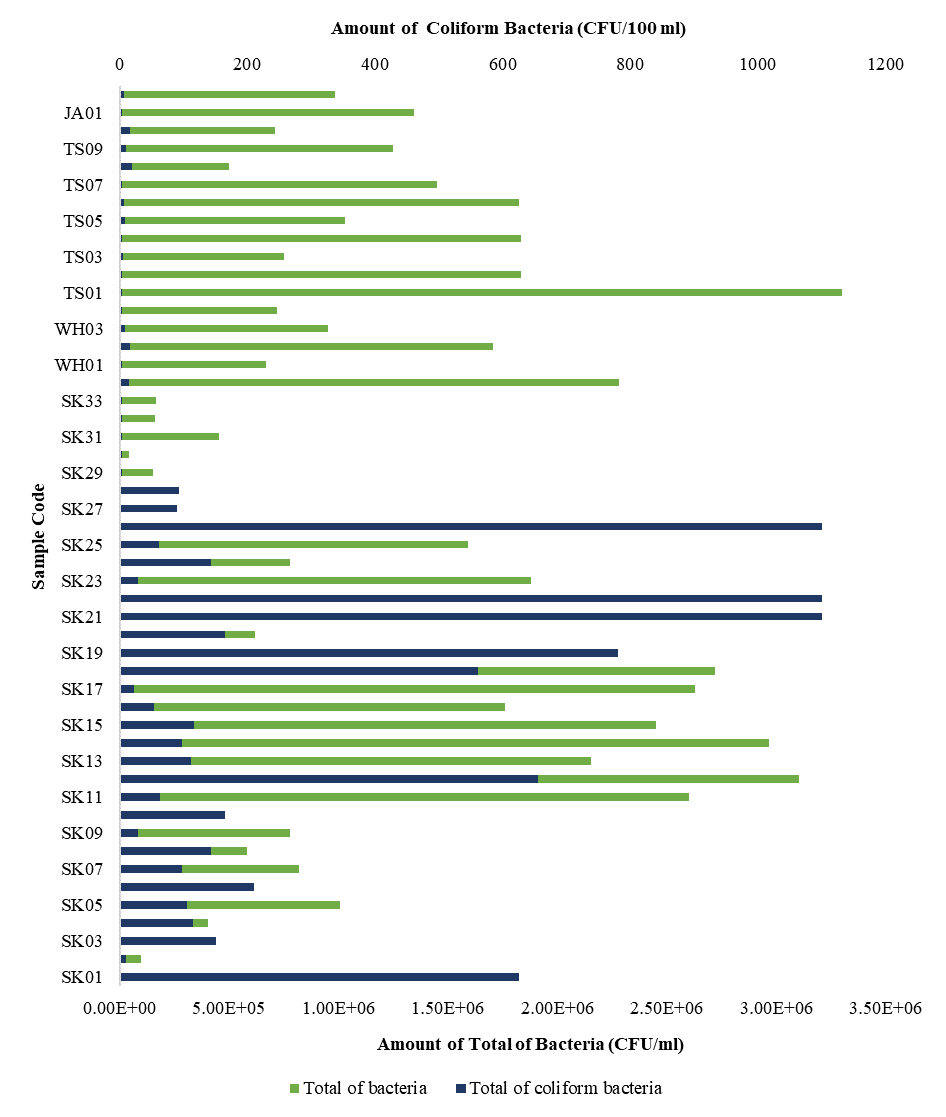Association of Household Environment and Family Habits with Respiratory Allergy Symptoms in Children

Introduction: Respiratory allergy symptoms in children still pose challenges in Indonesia regions, including big cities such as Surabaya. Several studies have found a relationship between household environment and family habits. The study aimed to identify the relationship between household environment and family habits with the incidence of respiratory allergies in children. Methods: This study used a cross-sectional design and was conducted on children aged 5-15 years with respiratory problems in the past three months. A questionnaire adapted from the International Childhood Asthma and Allergy Research (ISAAC) was used to see the respiratory allergy symptoms occurring in children. For statistical tests, this study used the Chi-square test, Fisher exact test, and logistic regression. Results : The data obtained showed a significant relationship between home furniture and building condition with respiratory allergy symptoms in children with OR values of 3.667 (CI: 1.068-12.586) and 3.747 (CI: 1.149-12.221), respectively. The use of air fresheners and insect repellent at home was also significantly related to respiratory allergy symptoms in children with OR values of 3.286 (CI: 1.063-10.152) and 4.200 (CI: 1.270-13.892), respectively. Conclusion: Household environment and family habits are associated with respiratory allergy symptoms in children. Household environment and family habits should be considered carefully, especially home furniture and building condition, also the habits of using fresheners and insect repellent should be avoided to prevent respiratory allergy symptoms in children. Conducting similar research and examination that involve larger samples to explore the cause-and-effect relationship between household environment and family habits with respiratory disease are very needed
Lv JJ, Kong XM, Zhao Y, Li XY, Guo ZL, Zhang YJ, et al. Global, Regional and National Epidemiology of Allergic Disorders in Children From 1990 To 2019: Findings from the Global Burden of Disease Study 2019. BMJ Open. 2024;14(4):1-12. https://doi.org/10.1136/bmjopen-2023-080612
Gilaberte Y, Pérez-Gilaberte JB, Poblador-Plou B, Bliek-Bueno K, Gimeno-Miguel A, Prados-Torres A. Prevalence and Comorbidity of Atopic Dermatitis in Children: A Large-Scale Population Study Based on Real-World Data. J Clin Med. 2020;9(6):1-12. https://doi.org/10.3390/jcm9061632
Hamelmann E, Csonka P, Roberts G, Vogelberg C, Cichocka-Jarosz E, Just J, et al. High Burden of Respiratory Allergy in Children Warrants Early Identification and Treatment with Allergen Immunotherapy. Respir Med. 2024;234(1):1-10. https://doi.org/10.1016/j.rmed.2024.107812
Sigurdardottir ST, Jonasson K, Clausen M, Lilja Bjornsdottir K, Sigurdardottir SE, Roberts G, et al. Prevalence and early-life risk factors of school-age allergic multimorbidity: The EuroPrevall-iFAAM birth cohort. Allergy: European Journal of Allergy and Clinical Immunology. 2021;76(9):2855–2865. https://doi.org/10.1111/all.14857
Kairavini NA, Ariani GAT, Utami S, Hikmallah N. Hubungan Tungau Debu Rumah Terhadap Angka Kejadian Rinitis Alergi yang Berobat di Poli THT Rsud Bangli Tahun 2019. Jurnal Kedokteran. 2020;5(2):57–68. http://dx.doi.org/10.36679/kedokteran.v5i2.237
Setiabudi J, Kawuryan DL, Putra DA. Hubungan antara Kejadian Penyakit Alergi dengan Prestasi Akademik Siswa SMP. Plexus Medical Journal. 2022;1(5):198–205. https://doi.org/10.20961/plexus.v1i5.463
Putri AA, Rahmawati I, Mardihusodo HR. Prevalence and Risk Factor that Caused Asthma in Children at Sumbang 1 Public Health Center Period of January 2018-December 2020. Mandala of Health. 2022;15(1):1-90. https://doi.org/10.20884/1.mandala.2022.15.1.5559
Soegiarto G, Abdullah MS, Damayanti LA, Suseno A, Effendi C. The Prevalence of Allergic Diseases in School Children of Metropolitan City in Indonesia Shows A Similar Pattern to That of Developed Countries. Asia Pac Allergy. 2019;9(2):1-10. https://doi.org/10.5415/apallergy.2019.9.e17
Wang J, Zhang Y, Li B, Zhao Z, Huang C, Zhang X, et al. Asthma and Allergic Rhinitis Among Young Parents in China in Relation to Outdoor Air Pollution, Climate and Home Environment. Science of the Total Environment. 2021;751(1):1-9. https://doi.org/10.1016/j.scitotenv.2020.141734
Husna R. Gambaran Lingkungan Rumah dan Perilaku Orang Tua dalam Pencegahan Alergi Pernapasan pada Anak di Wilayah Kerja UPT Puskesmas Batipuh I Kabupaten Tanah Datar Provinsi Sumatera Barat. Jurnal Kedokteran Syiah Kuala. 2022;22(1):1-10. https://doi.org/10.24815/jks.v22i1.24868
Huang S, Garshick E, Weschler LB, Hong C, Li J, Li L, et al. Home Environmental and Lifestyle Factors Associated with Asthma, Rhinitis and Wheeze in Children in Beijing, China. Environmental Pollution. 2020;256(1):1-23. https://doi.org/10.1016/j.envpol.2019.113426
Sultész M, Horváth A, Molnár D, Katona G, Mezei G, Hirschberg A, et al. Prevalence of Allergic Rhinitis, Related Comorbidities and Risk Factors in Schoolchildren. Allergy, Asthma and Clinical Immunology. 2020;16(1):1-11. https://doi.org/10.1186/s13223-020-00495-1
Norbäck D, Lu C, Zhang Y, Li B, Zhao Z, Huang C, et al. Sources of Indoor Particulate Matter (PM) and Outdoor Air Pollution in China in Relation to Asthma, Wheeze, Rhinitis and Eczema Among Pre-School Children: Synergistic Effects Between Antibiotics Use and PM10 and Second Hand Smoke. Environ Int. 2019;125(1):252–260. https://doi.org/10.1016/j.envint.2019.01.036
Riyanto A, Juariah L, Maharani RF, Megasari M. Risk Factors of Acute Respitatory Infection in Children Under Five in Banjaran Bandung Regency. KnE Medicine. 2022;2(2):1-45. https://doi.org/10.18502/kme.v2i2.11066
Guarnieri G, Olivieri B, Senna G, Vianello A. Relative Humidity and Its Impact on the Immune System and Infections. International Journal of Molecular Sciences. 2023;24(11):1-11. https://doi.org/10.3390/ijms24119456
Le Souëf PN, Adachi Y, Anastasiou E, Ansotegui IJ, Badellino HA, Banzon T, et al. Global change, climate change, and asthma in children: Direct and indirect effects - A WAO Pediatric Asthma Committee Report. World Allergy Organization Journal. 2024;17(11):1-13. https://doi.org/10.1016/j.waojou.2024.100988
Saijo Y, Yoshioka E, Sato Y, Azuma H, Tanahashi Y, Ito Y, et al. Relations of Mold, Stove, and Fragrance Products on Childhood Wheezing and Asthma: A Prospective Cohort Study from the Japan Environment and Children’s Study. Indoor Air. 2022;32(1):1-9. https://doi.org/10.1111/ina.12931
Sharma V, Sharma A, Joshi S, Ojha P, Soni S, Saxena A, et al. Human Health Risks to the Use of Chemical Mosquito Repellents: A Review. Int J Mosq Res. 2024;11(1):161–167. https://doi.org/10.22271/23487941.2024.v11.i1c.757
Li W, Liu Q, Chen Y, Yang B, Huang X, Li Y, et al. Effects of Indoor Environment and Lifestyle on Respiratory Health of Children in Chongqing, China. J Thorac Dis. 2020;12(10):6327–6341. https://doi.org/10.21037/jtd.2020.03.102
Baluch N, Gallant M, Ellis AK. Exposomal Research in the Context of Birth Cohorts: What Have They Taught Us?. Annals of Allergy, Asthma & Immunology. 2020;125(6):639–645 https://doi.org/10.1016/j.anai.2020.09.006
Steinemann A, Goodman N. Fragranced Consumer Products and Effects on Asthmatics: An International Population-Based Study. Air Qual Atmos Health. 2019;12(6):643–649. https://doi.org/10.1007/s11869-019-00693-w
Dwimawati E, Yanuaringsih GP, Pangaribuan R, Olivia N, Gurning FP, Pratama Y. Smoke Exposure at Home to the Incidence of Pneumonia in Children Under 5 Years Old. Indian Journal of Forensic Medicine & Toxicology. 2020;15(1):1872-1877. https://doi.org/10.37506/ijfmt.v15i1.13683
Zhuge Y, Qian H, Zheng X, Huang C, Zhang Y, Li B, et al. Effects of Parental Smoking and Indoor Tobacco Smoke Exposure on Respiratory Outcomes in Children. Sci Rep. 2020;10(1):1-9. https://doi.org/10.1038/s41598-020-60700-4
Rivera Rivera NY, Tamayo-Ortiz M, Mercado García A, Just AC, Kloog I, Téllez-Rojo MM, et al. Prenatal and Early Life Exposure to Particulate Matter, Environmental Tobacco Smoke and Respiratory Symptoms in Mexican Children. Environ Res. 2021;192(1):1-18. https://doi.org/10.1016/j.envres.2020.110365
Dai S, Chan KC. Associations of Household Environmental Tobacco Smoke Exposure with Respiratory Symptoms and Utilisation of Medical Services in Healthy Young Children in Hong Kong. Tob Induc Dis. 2020;18(2):1-9. https://doi.org/10.18332/tid/114461
Jung J, Park HJ, Jung M. Association between Parental Cotinine-verified Smoking Status and Childhood Asthma: A Population-based Nationally Representative Analysis. J Korean Med Sci. 2021;36(30):1–13. https://doi.org/10.3346/JKMS.2021.36.E193
Li Y, Huang X, Liu Q, Li W, Yang B, Chen Y, et al. Changes in Children’s Respiratory Morbidity and Residential Exposure Factors Over 25 Years in Chongqing, China. J Thorac Dis. 2020;12(10):6356–64. https://doi.org/10.21037/jtd-19-crh-aq-005
Mo Z, Lu S, Shao M. Volatile Organic Compound (VOC) Emissions and Health Risk Assessment in Paint and Coatings Industry in the Yangtze River Delta, China. Environmental Pollution. 2021;269(1):1-25. https://doi.org/10.1016/j.envpol.2020.115740
Ren J, Xu J, Zhang P, Bao Y. Prevalence and Risk Factors of Asthma in Preschool Children in Shanghai, China: A Cross-Sectional Study. Front Pediatr. 2022;9(1):1-10. https://doi.org/10.3389/fped.2021.793452
Alford KL, Kumar N. Pulmonary Health Effects of Indoor Volatile Organic Compounds—A Meta-Analysis. Int J Environ Res Public Health. 2021;18(4):1–12. https://doi.org/10.3390/ijerph18041578
Lv X, Jiang Y, Wang R, Li L, Liu R, Wang M. The Association Between Self-Reported Household Renovation and Semen Parameters Among Infertile Men: A Cross-Sectional Study. Am J Mens Health. 2023;17(1):1-7. https://doi.org/10.1177/15579883231156310
Gao Y, Han M. Efficiency Evaluation of Commonly Used Methods to Accelerate Formaldehyde Release and Removal in Households: A Field Measurement in Bedroom. Build Environ. 2025;268(1):1-8. https://doi.org/10.1016/j.buildenv.2024.112348
Vardoulakis S, Giagloglou E, Steinle S, Davis A, Sleeuwenhoek A, Galea KS, et al. Indoor Exposure to Selected Air Pollutants in The Home Environment: A Systematic Review. International Journal of Environmental Research and Public Health. 2020;17(23):1–24. https://doi.org/10.3390/ijerph17238972
Yan M, Zhai Y, Shi P, Hu Y, Yang H, Zhao H. Emission of Volatile Organic Compounds from New Furniture Products and Its Impact on Human Health. Human and Ecological Risk Assessment. 2019;25(7):1886–1906. https://doi.org/10.6084/m9.figshare.9862394.v1
Liang X, Zhang B, Wang K, Ji X, Geng Z, Chen C. Indoor Formaldehyde Pollution and Its Influencing Factors of Newly Decorated Residential Buildings in Kunshan City, Jiangsu Province. Current Urban Studies. 2022;10(2):263–274. https://doi.org/10.4236/cus.2022.102016
Pombu Senggunawu T. The Relationship Between Physical Sanitation of The House and The Incidence of ARI in Children Under Five in The Working Area of the Naioni Public Health Center in 2021. International Journal of Research Publications. 2022;99(1):160-171. https://doi.org/10.47119/ijrp100991420223085
Sabde YD, Trushna T, Mandal UK, Yadav V, Sarma DK, Aher SB, et al. Evaluation of Health Impacts of the Improved Housing Conditions on Under-Five Children in the Socioeconomically Underprivileged Families in Central India: A 1-Year Follow-Up Study Protocol. Front Public Health. 2022;10(1):1-9. https://doi.org/10.3389/fpubh.2022.973721
Aftab A, Noor A, Aslam M. Housing Quality and Its Impact on Acute Respiratory Infection (ARI) Symptoms Among Children in Punjab, Pakistan. PLOS Global Public Health. 2022;2(9):1-14. https://doi.org/10.1371/journal.pgph.0000949
Bakchi J, Rasel RA, Shammi KF, Ferdous S, Sultana S, Rabeya MR. Effect of Housing Construction Material on Childhood Acute Respiratory Infection: A Hospital Based Case Control Study in Bangladesh. Sci Rep. 2024;14(1):1-11. https://doi.org/10.1038/s41598-024-57820-6
Musiime AK, Krezanoski PJ, Smith DL, Kilama M, Conrad MD, Otto G, et al. House Design and Risk of Malaria, Acute Respiratory Infection and Gastrointestinal Illness in Uganda: A Cohort Study. PLOS Global Public Health. 2022;2(3):1-19. https://doi.org/10.1371/journal.pgph.0000063
Tustingi LS, Gething PW, Gibsoni HS, Greenwoodi B, Knudseni J, Lindsayi SW, et al. Housing and Child Health in Sub-Saharan Africa: A Cross-Sectional Analysis. PLoS Med. 2020;17(3):1-18. https://doi.org/10.1371/JOURNAL.PMED.1003055
Wimalasena NN, Chang-Richards A, Wang KIK, Dirks KN. Housing Risk Factors Associated with Respiratory Disease: A Systematic Review. International Journal of Environmental Research and Public Health. 2021;18(6):1–26. https://doi.org/10.3390/ijerph18062815
Osibona O, Solomon BD, Fecht D. Lighting in the Home and Health: A Systematic Review. International Journal of Environmental Research and Public Health. 2021;18(2):1–20. https://doi.org/10.3390/ijerph18020609
Liu W, Cai J, Huang C, Chang J. Residence Proximity to Traffic-Related Facilities is Associated with Childhood Asthma and Rhinitis in Shandong, China. Environ Int. 2020;143(1):1-9. https://doi.org/10.1016/j.envint.2020.105930
Eccles R. Why Is Temperature Sensitivity Important for the Success of Common Respiratory Viruses ?. Review in Medical Virology. 2021;31(1):1–8. https://doi.org/10.1002/rmv.2153
Zhang X, Xu K, Li Q, Zhu A, Yu J, Liu M, et al. Exploring the Impact of Ambient Temperature on Respiratory Diseases Admissions, Length of Stay, and Hospitalization Costs in Lanzhou City, Based on Distributed Lag Non-Linear Model. Clim Serv. 2024;34(1):1-10. https://doi.org/10.1016/j.cliser.2024.100481
Lee H, Yoon HY. Impact of Ambient Temperature on Respiratory Disease: A Case-Crossover Study in Seoul. Respir Res. 2024;25(1):1-11. https://doi.org/10.1186/s12931-024-02699-0
Achebak H, Rey G, Lloyd SJ, Quijal-Zamorano M, Méndez-Turrubiates RF, Ballester J. Ambient Temperature and Risk of Cardiovascular and Respiratory Adverse Health Outcomes: A Nationwide Cross-Sectional Study from Spain. Eur J Prev Cardiol. 2024;31(9):1080–1089. https://doi.org/10.1093/eurjpc/zwae021
Warobi W, Maretha DE, Asnilawati A, Masri M. The Effect of Exposure to Liquid Air Freshener on Histological of the Bronchial Mice (Mus musculus). Edubiotik : Jurnal Pendidikan, Biologi dan Terapan. 2021;6(2):1-17. https://doi.org/10.33503/ebio.v6i02.1219
Qiu Y, Zhou Y, Chang Y, Liang X, Zhang H, Lin X, et al. The Effects of Ventilation, Humidity, and Temperature on Bacterial Growth and Bacterial Genera Distribution. Int J Environ Res Public Health. 2022;19(22):1-13. https://doi.org/10.3390/ijerph192215345
Capone P, Lancia A, D’Ovidio MC. Interaction between Air Pollutants and Pollen Grains: Effects on Public and Occupational Health. Atmosphere. 2023;14(10):1-16. https://doi.org/10.3390/atmos14101544
Debelu D, Mengistu DA, Aschalew A, Mengistie B, Deriba W. Global Public Health Implications of Traffic Related Air Pollution: Systematic Review. Environ Health Insights. 2024;18(1):1-10. https://doi.org/10.1177/11786302241272403
Thao NT Van, Kien TG, Tuan TA, Duc NM, Hoang PM, Vu LT. Indoor Aeroallergen Sensitization and Associated Factors in Hospitalized Children with Asthma Exacerbations. Medical Archives. 2023;77(5):338–344. https://doi.org/10.5455/medarh.2023.77.338-344
Van Meel ER, Mensink-Bout SM, den Dekker HT, Ahluwalia TS, Annesi-Maesano I, Arshad SH, et al. Early-Life Respiratory Tract Infections and The Risk of School-Age Lower Lung Function and Asthma: A Meta-Analysis of 150.000 European Children. European Respiratory Journal. 2022;60(4):1-13. https://doi.org/10.1183/13993003.02395-2021
Adum P, Agyare VA, Owusu-Marfo J, Agyeman YN. Knowledge, Attitude and Practices of Malaria Preventive Measures among Mothers with Children Under Five Years in A Rural Setting of Ghana. Malar J. 2023;22(1):1-12. https://doi.org/10.1186/s12936-023-04702-3
Yadav VK, Malik P, Tirth V, Khan SH, Yadav KK, Islam S, et al. Health and Environmental Risks of Incense Smoke: Mechanistic Insights and Cumulative Evidence. Journal of Inflammation Research. 2022;15(1):2665–2693. https://doi.org/10.2147/jir.s347489
Sidibe A, Sakamoto Y, Murano K, Koita OA, Traore I, Dansoko Y, et al. Personal Exposure to Fine Particles (PM2.5) in Northwest Africa: Case of the Urban City of Bamako in Mali. Int J Environ Res Public Health. 2022;19(1):1-17. https://doi.org/10.3390/ijerph19010611
Prasasti CI, Haryanto B, Latif MT. Association of VOCs, PM2.5 and Household Environmental Exposure with Children’s Respiratory Allergies. Air Qual Atmos Health. 2021;14(8):1279–1287. https://doi.org/10.1007/s11869-021-01018-6

This work is licensed under a Creative Commons Attribution-NonCommercial-ShareAlike 4.0 International License.
1. Copyright of all journal manuscripts is held by the Jurnal Kesehatan Lingkungan.2. Formal legal provisions to access digital articles of electronic journal are subject to the provision of the Creative Commons Attribution-ShareAlike license (CC BY-NC-SA), which means that Jurnal Kesehatan Lingkungan is rightful to keep, transfer media/format, manage in the form of databases, maintain, and publish articles.
3. Published manuscripts both printed and electronic are open access for educational, research, and library purposes. Additionally, the editorial board is not responsible for any violations of copyright law.
JKESLING by UNAIR is licensed under a Creative Commons Attribution-ShareAlike 4.0 International License.







































